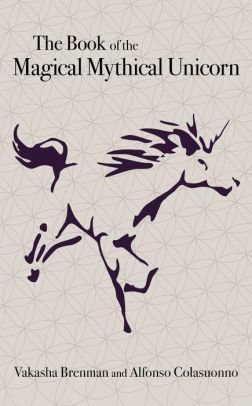The Book of the Magical, Mythical Unicorn compiles multiple, international sources of information on the myth, legend, and conjectured physical reality of the unicorn. It appears to have been a labor of love for Vakasha Brenman, one of the two authors, who was the founder of the non-profit Unicorn Archive. She completed this book with the writer, Alfonso Colasuonno, before she passed away this last summer. There is a definite New Age leaning in the writing referring to the unicorn as a multidimensional being that chooses to come down from higher dimensions to aid humans. There is a certain amount of liberty taken in the retelling of some legends to put the unicorn into a more spiritual light.
Sticklers for academic accuracy will find this lack of consistent, clear citation and creativity with the historical tales to be too much. While some of the book clearly references the source of information, many sections lack clear documentation. The works cited is very long but it is difficult to tell in which book you will find the reference. As a reviewer I was compelled to keep checking to see if I could find corroborating sources. For example, in the Hindu story of Rishyashringa, other sources say he is not the son of a unicorn but of a deer. The running theme on these changes from other sources was always to make the story more spiritual, more uplifting, or simply to extend the reach of the unicorn into other geographical areas. For this reason, my reaction to this book is mixed.
At times I thought it felt like grasping for a connection that may not truly be there. Are the rock paintings in South Africa really unicorns, or local animals that have gone extinct as some sources suspect? The same can be asked on the Siberian unicorn which may have been a type of ancient rhinoceros. In China, the quilin or kirin is described a a cow with scales and one horn. Is this the same unicorn the reader has in mind? Is it the same being or a different one?
The scope is huge-chasing the unicorn in Middle Eastern art; in Jewish and Zoroastrian stories; in history with unicorn encounters of Alexander the Great and Ghengis Khan; in European medieval manuscripts; in the Bible and in early American writing; from Argentinian prehistoric sites to Prester John in Ethiopia. One can imagine that Vakasha Brenman truly lived and breathed everything and anything relating to the unicorn. She was a believer. She was a fan. Knowing she was aging and wishing to share the information with the world, she found in Alfonso Colasuonno, an editor and writer who appreciated her creativity. From a technical perspective, the writing is clear, informative and interesting.
Without a doubt this book has more information, from more parts of the globe, than any other unicorn book I have read. The trouble is the reader cannot trust the authors to have all the facts straight. Given that this is a book about the magical and mythical, it begs the question is factual accuracy necessary? You decide. For those who are simply interested in the topic, it’s a good read and could send you off to make your own study of this fascinating, magical, mythical being.
~review by Larissa Carlson
Authors: Vakasha Brenman and Alfonso Colasuonno
O-Books, 2020
pp. 132, $ 13.57
The Book of the Magical, Mythical Unicorn: A Unique Anthology of Esoteric Knowledge, Myths and Legends

©
2010 - 2024
Facing North
